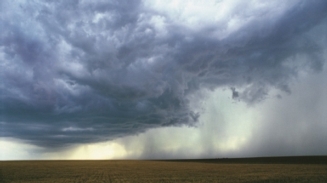
暴雨期间的农田可以释放碳雾
Farm Fields Release Carbon Mist during Rainstorms
暴雨期间的农田可以释放碳雾
Raindrops eject carbon-based blobs of soil material from wet fields, creating a mist of organic compounds above the soil.
雨滴从潮湿的土壤中喷射出碳基水泡,在土壤上方的空气中形成由有机化合物组成的雾气。
撰文:Christopher Intagliata
翻译:陈旭琦
审校:吴非
统筹:李轩
There's nothing like that fresh, rain-washed air after a storm, right? "The idea has always been 'the rain is cleaning.'" Mary Gilles, a chemist at Lawrence Berkeley Lab. She and her colleagues study microscopic airborne particles, so "normally we don't collect during rain. Because our intuition is, 'the air's clean, why would we be collecting right now?'"
没有什么东西能够比得上暴风雨后的新鲜、清新的空气,不是吗?“一直以来的观点是:雨水可以清洁空气。”劳伦斯伯克利国家实验室的化学家Mary Gilles如是说。她和她的同事们在研究通过空气传播的微粒。“通常我们不在下雨时收集空气,因为我们的直觉是,空气正在被清洁,为什么我们要现在收集?”
Two years ago, they went against that intuition and collected after a rainstorm, at a field in northern Oklahoma. And what they found was actually a wealth of particles—about half a micron in diameter, nearly spherical, and glassy-looking under the microscope. Lab analysis revealed the miniscule bits to be carbon-based blobs of soil material—like decayed bits of plants and soil-dwellers.
两年前,他们反直觉而行之。在一次暴风雨之后,他们在俄克拉何马州北部的一个农田上收集了空气。结果,他们发现了大量微粒,这些微粒直径大约有0.5微米,接近于球形,在显微镜下呈玻璃状。实验室分析显示,这些微粒原本是土壤中的碳基,例如,植物和土壤中的生物腐烂后的产物。
But how they got airborne was a mystery. The researchers think that what’s happening, based on a follow-up experiment, goes something like this. The rain leads to puddles. Organic matter leaches into those puddles, forming a film on top of the water. Then, as raindrops strike, they form tiny air bubbles. These bubbles rise to the surface and burst through that layer of organic material, catapulting the soil particles into the air. The study is in the journal Nature Geoscience. [Bingbing Wang et al, Airborne soil organic particles generated by precipitation]
但是它们怎样在空气中传播则是一个谜题。研究人员们根据随后的实验,找到了一种解释。雨水会形成水坑,当有机物质渗入这些水坑,会在积水的表面形成一层薄膜。随后的雨滴落在水坑中会形成微小的气泡。这些气泡升至表面并冲破有机物质形成的薄膜,将土壤微粒投射到空气中。这一研究刊载在《自然·地球科学》(Nature Geoscience)杂志中。
Tiny as they may be, the particles may actually affect the climate. "We think that they have the potential to actually be absorbing incoming solar radiation, and then that feeds back into global climate change." Meaning we might want to factor them into climate models. ‘Cause they appear to be more than just dust in the wind.
虽然它们非常渺小,但是这些微粒可能会影响气候。“我们认为它们可能会吸收入射的太阳辐射,从而对全球气候变化造成一定的影响。”这意味着我们或许需要将它们纳入气候模型。因为看起来它们不仅仅是风中的沙尘。
未经书面许可任何人不得复制或镜像
京ICP备11000850号-1
 京公网安备11010502039775号
京公网安备11010502039775号 信息网络传播视听节目许可证0111611号
国家科技基础条件平台

















